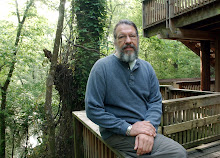Festival-goer (Slummin' at the Chinese tallow booth) ...
(photo by Russ Norwood) http://perceptivist.com/
It all started about three weeks ago when American Robins began piling into the hackberry grove that lines the northern and eastern borders of our backyard. Looking up into the leafless hackberry trees, I was surprised to see them loaded with fruit, despite the dry year that we've just experienced. In fact, it looked like the biggest hackberry crop that I'd ever seen in the 28 years that we've lived back here. Of further interest was the fact that these robins are about a month early this year. Normally, they don't go for our hackberry crop until very late December or early January.
As the days wore on, more and more robins piled in. Primary feasting time was dawn through about 9:00am each day. This morning (17 Dec) I estimated the robin flock to contain about 400 individuals. Originally, I figured about half that amount, but then an adult female Cooper's Hawk zipped overhead and flushed the entire flock into a southbound beeline, at which point I could best estimate the actual numbers of the flock.
Eastern Bluebird (photo by John Spohrer)
Several days ago I noted that two families (about 10 birds, total) of bluebirds had occupied a kinder/gentler, more isolated hackberry clump behind our barn, where they merrily chatted and ate to their hearts' content for four mornings running.
One morning I also noted a lone bluejay snagging hackberries amidst a small flock of robins right off the eastern edge of our back porch. I watched him for awhile, as I have not seen many bluejays engaging in frugivorous (fruit-eating) behavior. Unlike the robins, this bluejay was plucking hackberries one by one, holding them against a branch with his feet, and cracking them open with his bill, much like chickadees and titmice do with sunflower seeds. He worked quickly – almost as quickly as the nearby robins, who were simply plucking fruits and swallowing them whole.
Cedar Waxwing (photo by John Spohrer)
All along, Cedar Waxwings became attracted into the fray; and this morning I estimated 75-125 of them working the backyard hackberries. This is very early for Cedar Waxwings to be occurring in such numbers. Normally we don't see large concentrations of them down here until holly fruit time (Jan-Feb). And I know I've never seen this many Cedar Waxwings in our yard at one time.
Hackberries really pull in the birds, ya'll. In a statewide bird frugivory survey that a number of us conducted 1994-98, hackberry reigned supreme in terms of the diversity of bird species (27, total) that we recorded using the fruits.
Hackberry Fruits & Foliage (Celtis laevigata)
The hackberry is known to foresters as the “sugarberry,” due to its insipidly sweet fruits. The fruit might look juicy, but it's not – comprised mainly a thin rind, a dab of slimy, pumpkin-colored pulp, and a big seed. But boy do birds love them. Raccoons and squirrels too. On several occasions, Lydia and I have seen raccoons ardently eating green hackberries in August, way before they're ripe.
The Louisiana Francophone name for hackberry is bois connu, a corruption of, “the unknown tree.” Interestng name, non? I've heard a number of possible interpretations for naming it that, but the one I like best is that the hackberry tree was a species which colonists had never encountered in Europe. . . whereas many other New World trees that they enountered such as maples, elms, oaks, chestnuts, etc. had Old World counterparts.
The hackberry natively occurs throughout most of the U.S., excluding only the northern Great Plains, Upper Midwest, and northeastern U.S. Hackberries grow in just about every Louisiana parish. They are primarily bottomland hardwood inhabitants, thriving in high-clay-content alluvium, especially along the densely-forested floodplains of rivers, bayous, and other streams.






Great post on the much maligned hackberry, my friend. Also the bird photos that you are using are absolutely wonderful. Thanks.
ReplyDelete